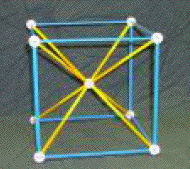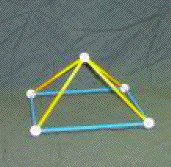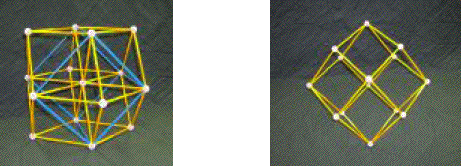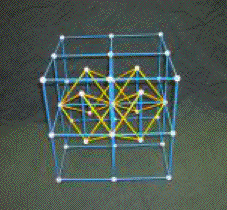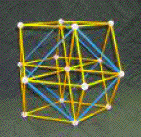|
Rhombic Dodecahedron - Hidden Within or Surrounding the Cube?
Concepts: Geometric Solids, Measurement Skills: Making constructions in three-dimensions (of cubes, square pyramids, and rhombic dodecahedrons), dissecting solids, finding lengths, recognizing three-dimensional relationships, problem solving. Grade Level/Strand: Secondary geometry Class Time: 1-2 class periods to build the models, complete the worksheet, and conduct the classroom discussion. Materials:
Prerequisites: Students should be familiar with the Pythagorean Theorem and have some knowledge of irrational numbers. For this student activity, assume in Figure 1 that the cube has edge length of 2 units, resulting in face diagonals of length 2√2, and interior diagonals of 2√3 units for the cube.
Figure 1: Cube with Interior Diagonals The edge lengths for the square-based pyramids in Figure 2 are 2 units and √3 units.
Figure 2: Square Pyramid Formed by Cube Face and Parts of Diagonals Each of the square pyramids formed in Figure 1 are attached to either the original cube or a congruent cube forming the rhombic dodecahedron of Figure 3a. A different view with the original cube removed is seen in Figure 3b.
Figure 3: (a) Rhombic Dodecahedron (b) Rhombic Dodecahedron The rhombic dodecahedron, dual of the cuboctahedron, is a fascinating polyhedron, although not one of the Platonic or Archimedian Solids. It is best known in nature as the crystalline shape of the garnet, the January birthstone. In this lesson, students explore the relationship of the rhombic dodecahedron to the cube and the space-filling or tessellating properties of both polyhedra. Students discover the relationship between the edges and diagonals of a cube. By analyzing the three different lengths found in a cube, students naturally derive the irrational numbers √1, √2, and √3. Additionally, they explore dissections of three-dimensional objects by comparing the unusual rhombic dodecahedron to the familiar cube. This is a mathematically rich problem to illustrate common algebraic and geometric concepts in two and three-dimensions. Directions: Prepare sample models of a cube (Figure 1), square pyramids (Figure 2), and rhombic dodecahedron (Figure 3a and 3b) using Zome tools For the cube, use 12 blue struts for edges and 8 balls for vertices. Complete with 8 yellow struts and 1 ball for the inside diagonals and center. Also prepare six square-based pyramids using 4 blue edges, 4 yellow diagonal edges, and 5 balls for vertices. The rhombic dodecahedron is built starting with a cube as in Figure 1 and is completed with square pyramids (Figure 2) placed on each of the six faces as in Figure 3a. Additionally, prepare a rhombic dodecahedron using 24 yellow struts and 14 white balls as in Figure 3b. If using clear straws instead of Zome tools, prepare models using blue curling ribbon inside full length straws for the blue struts and yellow curling ribbon inside 7/8 length straws for yellow struts. For this activity, edge lengths are 2 units; thus yellow lengths would be √3 or may be approximated for this construction as 1.75 units. Therefore, a 1.75 unit is 7/8 of a 2-unit straw. Folding a piece of paper equal in length to a straw is an easy place to start. By folding this piece of paper in half three times to create eighths, it is easy to create a template to cut straws that are 7/8 the length of the original straws. Arrange students in groups of 3 or 4. Each group needs a cup or Ziploc bag containing 12 blue struts, 8 yellow struts, and 9 white balls, and each student in the group needs a worksheet. If you have enough Zome tools, each group should also get several sets of 4 blue, 4 yellow, and 5 balls to make square-based pyramids to use as "jackets" to surround their cubes. Have students build their models and work through the worksheet. Circulate among the groups to answer questions and to check for understanding of key concepts. Make use of the prepared models to question students and probe student understanding. Allow ten to fifteen minutes at the end of class to bring the groups together as a large group and discuss findings. Questions that may be asked of students to help achieve the objectives of the lesson follow:
Extensions: More about Rhombic Dodecahedra
References: Frost, J. and Cagle, P. An Amazing Space Filling, Non-regular Tetrahedron, Holden, A. Shapes, Space, and Symmetry. New York: Columbia University Press, 1971. Pierce, P. and S. Polyhedra Primer. Palo Alto: Dale Seymour Publications, 1978. Schattschneider, D. and Walker, W. M. C. Escher Kaleidocycles, Petaluma, CA: Pomegranate Communications, 1987. Additional Geometry Resources: Bulatov, V. Polyhedra Collection, Eppstein, David The Geometry Junkyard: Three-dimensional Geometry, The Math Forum Internet Mathematics Library: Math Topics: Geometry, Answers to Worksheet:
Answers to Extensions: c. The angles of the rhombus are approximately 109.47° and 70.53° to the nearest hundredth. (Use basic trigonometric functions on the rhombus when it is separated into right triangles.)
d. f. Student answers may vary, but among the answers you may find some of the following: square, trapezoid, equilateral, isosceles, and scalene triangles, octagon, heptagon, and hexagon. Squares and equilateral triangles are always regular. The octagon and hexagon can be regular or non-regular depending on the angle of the slice. g. Student responses will vary, but some possible responses are: all hexagons, equilateral triangles, squares and hexagons, rhombi and hexagons, octagons and squares, and equilateral triangles and hexagons. |
